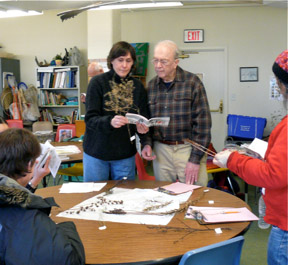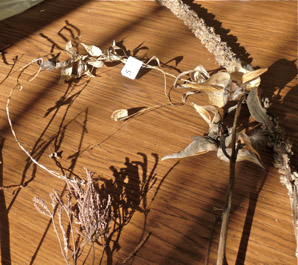February 7, 2010
Winter Weed Identification - Maynard Ecology Center
A Friends of Fresh Pond Reservation Program
Barbara Strell lead a talk which described how to use identify winter
weeds when in the field by using the Winter Weed Finders by Dorcas
Miller. With Barbara's instructions and demonstrations the talk focused
on "on hands" participation of book usage. After the talk,
participants practicedtheir new skills by going to four different tables
where thirty-two dried weeds were placed. At the end of the activity
attendees were treated to cookies, hot chocolate and tea.
Barbara Strell (left photo) is shown helping a gentleman
identify a weed by using Winter Weed Finders.
(middle photo) Four of the thirty-two weeds that participants practiced
with are (clockwise from lower left): Common (Blue) Vervain (Verbena
hastata), Black Swallowwort (Cynanchum louiseae), Common
Mullien (Verbascum thapsus), and Common Milkweed (Ascelepias
syriaca).
Elizabeth Wylde (right photo) spoke about Black Swallowwort (Cynanchum
louiseae), an invasive Eurasian vine that threatens both flora and fauna
at the Reservation. Black swallowwort crowd out native flora, like common
milkweed (Ascelepias syriaca)]. This threatens the Monarch Butterfly
(Danaus plexippus) population because the monarch lays its eggs on milkweed.
Due to the plants' similarities of swallowwort and milkweed, when black
swallowwort has pushed out milkweed, the monarch lays its eggs on black
swallowwort instead. Sadly, the larvae do not survive on black swallowwort.
Fortunately, there are several volunteer weeders (Elizabeth Wylde included)
who have made a significant impact on reducing black swallowwort's presence
at Fresh Pond.
Description and Photos by Carol Collura





